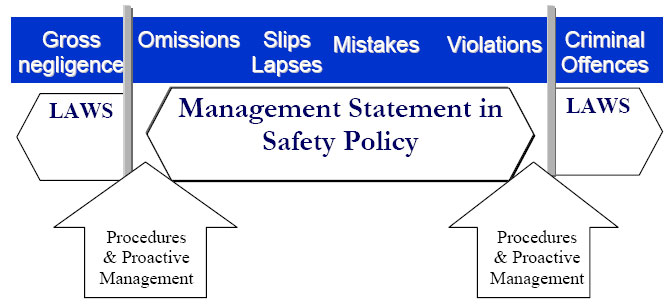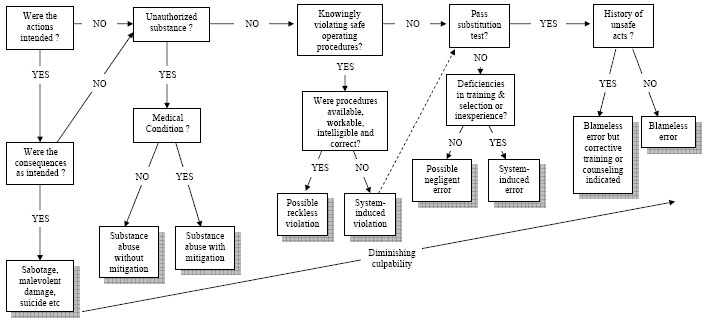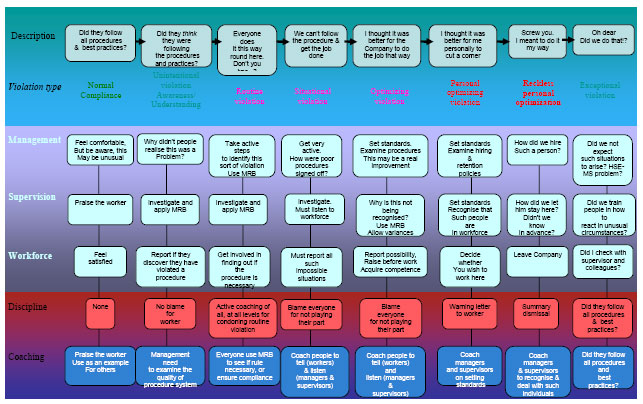
The Human Factors Analysis and Classification System—HFACS Cover
and Documentation
Introduction
1. Unsafe Acts
2. Preconditions
for Unsafe Acts
3. Unsafe Supervision
4. Organizational
Influences
Conclusion
References
HFACS and Wildland Fatality Investigations
Hugh Carson wrote this
article a few days after the Cramer Fire
Bill Gabbert wrote this article following the release of the Yarnell Hill Fire ADOSH report
A Roadmap to a Just Culture:
Enhancing the Safety Environment
Cover
and Contents
Forward by James Reason
Executive Summary
1. Introduction
2. Definitions and Principles of a Just Culture
3. Creating a Just Culture
4. Case Studies
5. References
Appendix A. Reporting Systems
Appendix B. Constraints to a Just Reporting Culture
Appendix C. Different Perspectives
Appendix D. Glossary of Acronyms
Appendix E. Report Feedback Form
Rainbow Springs Fire, 1984 — Incident Commander Narration
Introduction
Years Prior
April 25th
Fire Narrative
Lessons Learned
Conclusion
Tools to Identify Lessons Learned
An FAA website presents 3
tools to identify lessons learned from accidents. The site also
includes an animated
illustration of a slightly different 'Swiss-cheese' model called "defenses-in-depth."
|
A Roadmap to a Just Culture:
Enhancing the Safety Environment
Prepared by: GAIN Working Group E,
Flight Ops/ATC Ops Safety Information Sharing
First Edition • September 2004
2. Definitions and Principles of a Just Culture
2.1 Definition of Just Culture
According to Reason (1997), the components of a safety culture include:
just, reporting, learning, informed and flexible cultures. Reason describes
a Just
Culture as an atmosphere of trust in which people are encouraged (even
rewarded) for providing essential safety-related information, but in
which they are
also clear about where the line must be drawn between acceptable and
unacceptable behavior (See Figure 1).
A “Just Culture” refers to a way of safety thinking that promotes
a questioning attitude, is resistant to complacency, is committed to excellence,
and fosters both personal accountability and corporate self-regulation in
safety matters.
A “Just” safety culture, then, is both attitudinal as well as
structural, relating to both individuals and organizations. Personal attitudes
and corporate style can enable or facilitate the unsafe acts and conditions
that are the precursors to accidents and incidents. It requires not only actively
identifying safety issues, but responding with appropriate action.

Figure 1. Based on Reason (1997) The Components of Safety Culture: Definitions
of Informed, Reporting, Just, Flexible and Learning Cultures
2.2 Principles of a Just Culture
This section discusses some of the main
issues surrounding Just Culture, including the benefits of having a learning
culture versus a blaming culture; learning from unsafe acts; where the
border between “acceptable” and “unacceptable” behavior should
be; and ways to decide on culpability.
Evaluating the benefits of punishment versus learning
A question that organizations should ask themselves is whether or not the
current disciplinary policy is supportive to their system safety efforts.
- Is it more worthwhile to reduce accidents by learning from incidents
(from incidents being reported openly and communicated back to the
staff) or by punishing people for making mistakes to stop them from making
mistakes
in the future?
- Does the threat of discipline increase a person’s
awareness of risks or at least increase one’s interest in assessing
the risks? Does this heightened awareness outweigh the learning through punishment?
- By
providing safety information and knowledge, are people more interested
in assessing the risks? Does this heightened awareness outweigh the learning
through punishment?
- How does your system treat human error? Does
your system make an employee aware of their mistake? Can an employee
safely come
forward if they make a mistake, so that your organization can learn
from the event?
Positions for and against punishment as a means of learning are illustrated
below:
In favor of punishment of the negligent actor: “when people have
knowledge that conviction and sentence (and punishment) may follow conduct
that inadvertently creates improper risk, they are supplied with an additional
motive to take care before acting, to use their facilities and draw on their
experience in gauging the potentialities of contemplated conduct. To some
extent, at least, this motive may promote awareness and thus be effective
as a measure of control.” (American Law Institute Model Penal Code,
Article 2. General Principles of Liability, Explanatory Note 2.02, 1962).
Against punishment of the negligent actor: “a person acts “recklessly” with
respect to a result if s/he consciously disregards a substantial risk and
acts only “negligently” if s/he is unaware of a substantial risk
s/he should have perceived. The narrow distinction lies in the actor’s
awareness of risk. The person acting negligently is unaware of harmful consequences
and therefore is arguably neither blameworthy nor deterrable” (Robinson & Grall
(1983) Element Analysis in Defining Criminal Liability: The Model Penal Code
and Beyond. 35 Stan. L. Rev. 681, pp 695-96).
Learning from unsafe acts
A Just Culture supports learning from unsafe acts. The first goal of any
manager is to improve safety and production. Any event related to safety,
especially human or organizational errors, must be first considered as a valuable
opportunity to improve operations through experience feedback and lessons
learnt (IAEAa).
Failures and ‘incidents’ are considered by organizations with
good safety cultures as lessons which can be used to avoid more serious events.
There is thus a strong drive to ensure that all events which have the potential
to be instructive are reported and investigated to discover the root causes,
and that timely feedback is given on the findings and remedial actions, both
to the work groups involved and to others in the organization or industry
who might experience the same problem. This ‘horizontal’ communication
is particularly important (IAEAb).
Organizations need to understand and acknowledge that people at the sharp
end are not usually the instigators of accidents and incidents and that they
are more likely to inherit bad situations that have been developing over a
long period (Reason, 1997). In order that organizations learn from incidents,
it is necessary to recognize that human error will never be eliminated; only
moderated. In order to combat human errors we need to change the conditions
under which humans work. The effectiveness of countermeasures depends on the
willingness of individuals to report their errors, which requires an atmosphere
of trust in which people are encouraged for providing essential safety-related
information (Reason, 1997).
2.3 Four types of unsafe behaviors
Marx (2001) has identified four types
of behavior that might result in unsafe acts. The issue that has been
raised by Marx (2001) and others is that not all of these behaviors necessarily
warrant
disciplinary sanction.
- Human error – is when there is general agreement that the individual
should have done other than what they did. In the course of that conduct where
they inadvertently caused (or could have caused) an undesirable outcome, the
individual is labeled as having committed an error.
- Negligent conduct – Negligence
is conduct that falls below the standard required as normal in the community.
Negligence, in its legal sense, arises both in the civil and criminal liability
contexts. It applies to a person who fails to use the reasonable level of
skill expected of a person engaged in that particular activity, whether by
omitting to do something that a prudent and reasonable person would do in
the circumstances or by doing something that no prudent or reasonable person
would have done in the circumstances. To raise a question of negligence, there
needs to be a duty of care on the person, and harm must be caused by the negligent
action. In other words, where there is a duty to exercise care, reasonable
care must be taken to avoid acts or omissions which can reasonably be foreseen
to be likely to cause harm to persons or property. If, as a result of a failure
to act in this reasonably skillful way, harm/injury/damage is caused to a
person or property, the person whose action caused the harm is liable to pay
damages to the person who is, or whose property is, harmed.
- Reckless conduct – (gross
negligence) is more culpable than negligence. The definition of reckless conduct
varies between countries, however the underlying message is that to be reckless,
the risk has to be one that would have been obvious to a reasonable person.
In both civil and criminal liability contexts it involves a person taking
a conscious unjustified risk, knowing that there is a risk that harm would
probably result from the conduct, and foreseeing the harm, he or she nevertheless
took the risk. It differs from negligence (where negligence is the failure
to recognize a risk that should have been recognized), while recklessness
is a conscious disregard of an obvious risk.
- Intentional “willful” violations – when
a person knew or foresaw the result of the action, but went ahead and did
it anyway.
2.4 Defining the border of “unacceptable behavior”
The
difficult task is to discriminate between the truly ‘bad behaviors’ and
the vast majority of unsafe acts to which discipline is neither appropriate
nor useful. It is necessary to agree on a set of principles for drawing
this line:
Definition of Negligence: involved a harmful consequence that a ‘reasonable’ and ‘prudent’ person
would have foreseen.
Definition of Recklessness: one who takes a deliberate and unjustifiable
risk.
Reason (1997) believes that the line between “culpable” (or “unacceptable”)
and “acceptable” behavior should be drawn after ‘substance
abuse for recreational purposes’ and ‘malevolent damage.’

The following figure (Figure 2) illustrates the borders between “acceptable” and “bad” behaviors,
where statements in the safety policy can deal with human error (such as omission,
slips etc), and where laws come into play when criminal offenses and gross
negligence are concerned. Procedures and proactive management can support
those situations that are less clear, at the borders.

Figure 2. Defining the borders
of “bad behaviors” (From
P. Stastny Sixth GAIN World Conference, Rome, 18-19 June, 2002)
2.5 Determining ‘culpability’ on an individual case basis
In
order to decide whether a particular behavior is culpable enough to require
disciplinary action, a policy is required to decide fairly on a case-by-case
basis. Three types of disciplinary policy are described below (Marx,
2001). The third policy provides the basis for a Just Culture. Reason’s Culpability
Decision-Tree follows, presenting a structured approach for determining culpability.
This is followed by Hudson’s (2004) expanded Just Culture diagram, which
integrates types of violations and their causes, and accountabilities at all
levels of the organization.
- Outcome-based Disciplinary Decision Making – focuses
on the outcome (severity) of the event: the more severe the outcome, the
more blameworthy the
actor is perceived. This system is based on the notion that we can totally
control
the outcomes from our behavior. However, we can only control our intended
behaviors to reduce our likelihood of making a mistake, but we cannot
truly control when and where a human error will occur. Discipline may
not deter
those who did not intend to make a mistake (Marx, 2001).
- Rule-based Disciplinary Decision Making – Most high-risk industries have
outcome-based rules (e.g. separation minima) and behavior-based rules
(e.g. work hour limitation). If either of these rules is violated, punishment
does
not necessarily follow, as for example, in circumstance where a large
number of the rules do not fit the particular circumstances. Violations
provide critical
learning opportunities for improving safety – why, for example,
certain violations become the norm.
- Risk-based Disciplinary Decision Making – This method considers
the intent of an employee with regard to an undesirable outcome. People
who act
recklessly, are thought to demonstrate greater intent (because they
intend to take a significant and unjustifiable risk) than those who demonstrate
negligent
conduct. Therefore, when an employee should have known, but was unaware,
of the risk s/he was taking, s/he was negligent but not culpably so, and
is therefore
would not be punished in a Just Culture environment.
Reason’s Culpability Decision-Tree – Figure 3 displays a decision tree
for helping to decide on the culpability of an unsafe act. The assumption
is that the actions under scrutiny have contributed to an accident or to
a serious incident. There are likely to be a number of different unsafe acts
that contributed to the accident or incident, and Reason (1997) believes
that
the decision tree should be applied separately to each of them. The concern
is with individual unsafe acts committed by either a single person or by
different people at various points of the event sequence. The five stages
include:
-
Intended act: The first question in the decision-tree relates to intention,
and if both actions and consequences were intended, then it is possibly
criminal behavior which is likely to be dealt with outside of the company
(such as
sabotage or malevolent damage).
-
Under the influence of alcohol or drugs known to impair
performance at the time that the error was committed. A distinction is
made between substance abuse with and without ‘reasonable
purpose (or mitigation), which although is still reprehensible, is
not as blameworthy
as taking drugs for recreational purposes.
-
Deliberate violation of the rules and did the system
promote the violation or discourage the violation; had the behavior become
automatic or part
of the ‘local working practices.’
-
Substitution test: could a different
person (well motivated, equally competent, and comparably qualified)
have made the same error under similar circumstances (determined by
their peers).
If “yes” the person who made the error is probably blameless,
if “no”, were there system-induced reasons (such as insufficient
training, selection, experience)? If not, then negligent behavior
should be considered.
-
Repetitive errors: The final question asks whether the
person
has committed unsafe acts in the past. This does not necessarily
presume culpability, but it may imply that additional training or counseling
is
required.
Reason’s
Foresight test: provides a prior test to the substitution test described above,
in which culpability is thought to be dependent upon the kind of behavior
the person was engaged in at the time (Reason and Hobbs, 2001).
The type of question that is asked in this test is:
— Did the individual knowingly engage in behavior that an average
operator would recognize as being likely to increase the probability
of making
a safety-critical error?
If the answer is ‘yes’ to this question in any of the following
situations, the person may be culpable. However, in any of these situations,
there may be other reasons for the behavior, and thus it would be necessary
to apply the substitution test.
- Performing the job under the influence of a drug or substance known
to impair performance.
- Clowning around whilst on the job.
- Becoming
excessively fatigued as a consequence of working a double shift.
- Using
equipment known to be sub-standard or inappropriate.
Hudson’s
Version of the Just Culture Diagram (Figure 4)
Hudson (2004) expands Reason’s Culpability Decision tree, using a more
complex picture that integrates different types of violation and their causes.
This model starts from the positive, indicating that the focus of priority.
It defines accountabilities at all levels and provides explicit coaching definitions
for failures to manage violations. This approach (called “Hearts and
Minds”) includes the following four types of information to guide those
involved in deciding accountability:
- Violation type - normal compliance to exceptional violation
- Roles of
those involved - managers to workers
- Individuals -the reasons for
non-compliance
- Solutions - from praise to punishment

Figure 3. From
Reason (1997) A decision tree for determining the culpability of unsafe
acts. p209 (click for larger image)

Figure 4. Hudson’s
refined Just Culture Model (From the Shell “Hearts
and Minds ” Project, 2004) (click for larger image)
Determining Negligence: an example (SRU, 2003)
- Was the employee aware of what he or she has done? NO
- Should
he have been aware? YES
- Applying the “Substitution Test”:
Substitute the individual concerned with the incident with someone else
coming from the same area of work and having comparable experience and
qualifications. Ask the “substituted” individual: “In
the light of how events unfolded and were perceived by those involved
in real time, would you have behaved any differently?” If the
answer is “probably not”, then apportioning blame has no
material role to play.
- Given the circumstances that prevailed at the
time, could you be sure that you would not have committed the
same or similar type of unsafe act? If the answer again is “probably not”,
the blame is inappropriate.
|
Dealing with repetitive errors
Can organizations afford someone who makes repeated errors while
on the job? The answer to this question is difficult as the causes
of repeat errors have two different sources:
1) An individual may be performing a specific task that is very prone
to error. Just as we can design systems to minimize human error through
human factors, we can design systems that directly result in a pronounced
rate of error. Therefore it is critical for the designers to be aware
of the rate of error.
2) A source of repeated error may be with the individual. Recent traumatic
events in one’s life or a significant distraction in life can
cause some individuals to lose focus on the details of their work, possibly
leading to an increased rate of error. In such cases, it may be an appropriate
remedy to remove the individual from his current task or to supplement
the task to aid in controlling the abnormal rate of error. |
What to do with lack of qualification?
An unqualified employee can cross the threshold of recklessness if
he does not recognize himself as unqualified or as taking a substantial
risk in continuing his current work. Lack of qualification may only
reveal that an individual was not fully trained and qualified in the
job and therefore show that it is a system failure not to have ensured
that the appropriate qualifications were obtained. |
<<< continue
reading—A Roadmap to a Just Culture, Creating a Just Culture >>>
Reprinted by permission
from the Global Aviation Information Network.
|